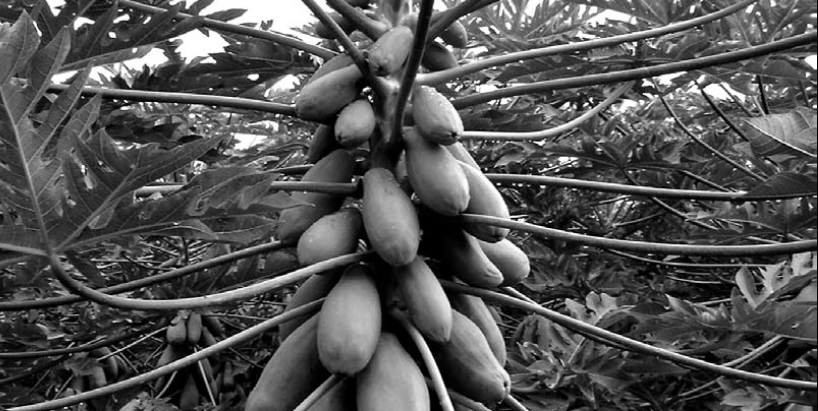Effect of five substrates on growth indices of papaya (Carica papaya L.) plants under glasshouse conditions

Abstract
In this experiment there were evaluated the effects of five substrates (peat, soil, peat + burned rice husks mixture, sand and the so-called “conventional substrate”) on the ‘Maradol’ papaya and the ‘Tainung-1’ hybrid plant growth, under greenhouse conditions, at the National University of Colombia, in Bogota. Leaf area and dry matter weight were weekly measured, from germination to 56 days after emergence (DAE) period. Leaf area index (LAI), relative growth rate (RGR), crop growth rate (CGR) and net assimilation rate (NAR) were calculated. Peat (Klasmann®), was the most suitable substrate for both materials, because provided the best physical and chemical conditions for both growth and development. Thus, results showed that plants growing on both materials showed preference to peat-moss. The ‘Tainung-1’ hybrid showed a better behavior with respect to ‘Maradol’. Finally, the plants growing on peat showed the highest CGR values with 1.34 g·cm-2·day-1 for ‘Tainung-1’ and 1.20 g·cm-2·day-1 for ‘Maradol’. Furthermore, the supply of rice husks or hen manure affected negatively leaf area and shoot development.
Keywords
‘Maradol’ variety, ‘Tainung-1’ hybrid, Peat, Growth rates
References
- Abad, M., P. Noguera y C. Carrión. 2004. Los sustratos en los cultivos sin suelo. pp. 113-158. En: Urrestarazu, M. (ed.) Tratado de cultivos sin suelo. Ediciones Mundi-Prensa, Madrid.
- Arp, W.J. 1991. Effects of source-sink relations on photosynthetic acclimation to elevated CO2. Plant Cell Environ. 14, 869-875.
- Barraza, F., G. Fischer y C. Cardona. 2004. Estudio del proceso de crecimiento del cultivo del tomate (Lycopersicon esculentum Mill.) en el valle del Sinú medio, Colombia. Agron. Colomb. 22(1), 81-90.
- Baiyeri, K.P. 2006. Seedling emergence and growth of pawpaw (Carica papaya) grown under different coloured shade polyethylene. Institute of Agrophysics, Polish Academy of Sciences 20, 77-84.
- Calderón, S. y F. Cevallos. 2001. “los sustratos”. En: http://www.drcalderonlabs.com/Publicaciones/Los_Sustratos.htm; consulta: junio de 2004.
- Clavijo, J. 1989. Análisis del crecimiento en malezas. Revista Comalfi 26, 12-16.
- Dubik, S.P., D.P. Krizek y D.P. Stimart, 1990. Influence of root zone restriction on mineral element concentration, water potential, chlorophyll concentration, and partitioning of assimilate in spreading euonymus (E. kiautschovica Loes. Sieboldiana). J. Plant Nutr. 13, 677-699.
- Evans, G.C. 1972. The cuantitative analysis of plant growth. Studies in ecology. Vol.1. Blackwell Scientific Publication, Londres. pp. 45-68.
- González, C., M.F. Quintero y V. Meneses. 2006. Determinación de algunas propiedades hidrofísicas de k, los sustratos utilizados en cultivos de flores en la sabana de Bogotá. pp. 427-450. En: Flórez, V.; A. Fernández; D. Miranda; B. Chaves y M. Guzmán (eds.). Avances sobre fertirriego en la floricultura colombiana. Unibiblos, Bogotá.
- Hameed, M.A., J.B. Reid y R.N. Rowe. 1987. Root confinement and its effects on the water relations, growth and assimilate partitioning of tomato (Lycopersicun esculentum Mill). Ann. Bot. 59, 685-692.
- Hanson, P.J., R.K. Dixon y R.E. Dickenson. 1987. Effect of container size and shape on the growth of northern red oak seedlings. HortScience 22, 1293-1295.
- Hee Choi, J., G. Chae Chung, S. Ryong Suh, J. Ah Yu, J. Hoon Sung y K. Ju. 1997. Suppression of calcium transport to shoots by root restriction in tomato plants. Plant Cell Physiol. 38, 495-498.
- Hernández, M.S., A. Casas, O. Martínez y J.A. Galvis. 1995. Análisis y estimación de parámetros e índices de crecimiento del árbol de maraco (Theobroma bicolor H.B.K.) a primera floración. Agron. Colomb. 12(1), 182-191.
- Hsu, Y.M., M.J. Tseng y C.H. Lin. 1996. Container volume effects growth and development of wax-apple. HortScience 31, 1139-1142.
- Hunt, R. 1990. Basic growth analysis: plant growth analysis for beginners. Unwin Hyman, Londres. 112p.
- Liu, A., y J.G. Latimer. 1995. Water relations and abscisic acid levels of watermelon as affected by rooting volume restriction. J. Exp. Bot. 46, 1011-1015.
- Mazorra, M., A. Quintana, D. Miranda, G. Fischer y B. Chaves. 2003. Análisis sobre el desarrollo y la madurez fisiológica del fruto de la uchuva (Physalis peruviana L.) en la zona de Sumapaz (Cundinamarca). Agron. Colomb. 21(3), 175-189.
- Montaldi, E. 1995. Principios de fisiología vegetal. Ediciones Sur, La Plata, Argentina 298 p.
- Radford, P.J. 1967. Growth analysis formulae. Their use and abuse. Crop Sci. 7, 171-175.
- Ran, Y., B. Bar-Yosef y A. Erez. 1992. Root volume influence on dry matter production and partitioning as related to nitrogen and water uptake rates by peach tree. J. Plant Nutr. 15, 713-726.
- Richards, D. y R.N. Rowe. 1977. Effects of root restriction, root pruning, and 6-benzylaminopurine on the growth of peach seedlings. Ann. Bot. 41, 729-740.
- Rieger, M. y F. Marra. 1994. Responses of young peach trees to root confinement. J. Amer. Soc. Hort. Sci. 119, 223-228.
- Rodríguez, L., G. Corchuelo y C. Ñustez. 2003. Influencia del espaciamiento entre plantas sobre la morfología y el crecimiento de la papa (Solanum tuberosum L. cv. Parda pastusa) bajo dos ambientes contrastantes. Agron. Colomb. 21(3), 210-219.
- Salisbury, F.B. y C.W. Ross. 1994. Fisiología vegetal. Grupo Editorial Iberoamérica, México D.F. 760 p.
- Schaffer, B.C., C. Searle, A.W. Whiley y R.J. Nissen. 1996. Effects of atmospheric CO2 enrichment and root restriction on leaf gas exchange and growth of banana (Musa). Physiol. Plant. 97, 685-693.
- Tschaplinski, T.J. y T.J. Blake. 1985. Effects of root restriction on growth correlations, water relations and senescence of alder seedlings. Physiol. Plant. 64, 167-176.
- Unger, P.W. y T. Kaspar. 1994. Soil compaction and root growth: a review. Agron. J. 86, 759-766.
- Young, I.M., K. Montagu y J.A.G. Conroy, 1997. Mechanical impedance of root growth directly reduces leaf elongation rates of cereals. New Phytol. 135, 613-619.